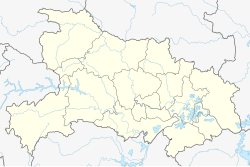Top Qs
Timeline
Chat
Perspective
Zhangwan, Shiyan
District in Hubei, China From Wikipedia, the free encyclopedia
Remove ads
Zhangwan District (simplified Chinese: 张湾区; traditional Chinese: 張灣區; pinyin: Zhāngwān Qū) is a district of the city of Shiyan, Hubei, China.[1][3]
Remove ads
History
Human activity in the area can be traced back to approximately 5000 BCE on the banks of the Du River.[1]
The area belonged to the Chu State during its existence.[1] The area later belonged to the Qin dynasty.[1]
The area was incorporated under the Jin dynasty as Weiyang County (微阳县).[1]
During the Sui dynasty and the early Tang dynasty, the area was incorporated as Duyang County (堵阳县).[1] In 627 CE, the county was dissolved and replaced by Yunxiang County (郧乡县).[1] Yunxiang County would itself be dissolved in 1277 under the Southern Song, and replaced by Yun County (郧县).[1] The area would remain as Yun County throughout subsequent dynasties, and through the rule of the Republic of China.[1]
In December 1947, Yun County was taken by Communist forces.[1] In subsequent years, the area would be re-organized multiple times.[1] The prefecture-level city of Shiyan was established in December 1969.[1]
Zhangwan was established as a county-level subdistrict (县级街道) in November, 1980.[1]
In May 1984, Zhangwan was re-organized as a district (区).[1]
On 13 June 2021, a gas explosion occurred in Zhangwan District.[4]
Remove ads
Geography
The district is located near the geographic center of Shiyan, bordering Maojian District to its southeast, and bordering Yunyang District elsewhere.[1]
Climate
Zhangwan District has a subtropical climate with four distinct seasons, long winters and summers, and short springs and autumns.[1] The average annual sunshine in the district is 1889.3 hours, the annual average temperature is 15.25 °C, and the annual average precipitation is 1000.8 millimetres.[1]
Remove ads
Administrative divisions
Zhangwan District administers 4 subdistricts, 2 towns, 2 townships, and 2 other township-level divisions.[3]
|
|
2 other township-level divisions are: Xicheng Development Zone (西城开发区) and Shiyan Industrial New Area (十堰工业新区).
Demographics
In the 2010 Chinese census, Zhangwan had a population of 368,471 people.[5] By 2015, the district's population rose to approximately 399,000 people.[6] By 2018, the district's population had risen further to approximately 415,000 people.[1]
Economy
As of 2018, Zhangwan District reported a GDP of 55.905 billion Yuan, of which, the primary sector contributed 0.288 billion Yuan, the secondary sector contributed 37.462 billion Yuan, and the tertiary sector contributed 18.155 billion Yuan.[1] In 2018, retail sales in the district totaled 15.3 billion Yuan, and government revenue totaled 1.09 billion Yuan.[1]
Agriculture, forestry, animal husbandry, and fishing contributed 489 million Yuan to the district's economy in 2018, the majority of which came from agriculture.[1] Major agricultural products in the district include wheat, corn, rice, and tea.[1]
Industry in the district is dominated by Dongfeng Motors, which operates a number of manufacturing plants in the district, producing commercial vehicles, off-road vehicles, and auto chassis.[1]
The district government is partaking in an ongoing poverty alleviation program, which it spent 390 million Yuan on in 2018, aiding 7,639 people.[1]
A number of natural sites in the district have been outfitted with tourism infrastructure, and there is significant tourism to Dongfeng's current and historic plants in the district.[1]
Remove ads
Transportation
Rail
The Xiangyang–Chongqing railway runs through the district.[1]
Road
National Highway 209, National Highway 316, and the Yinchuan-Wuhan section of the G70 Expressway all pass through the district.[1]
References
Wikiwand - on
Seamless Wikipedia browsing. On steroids.
Remove ads


